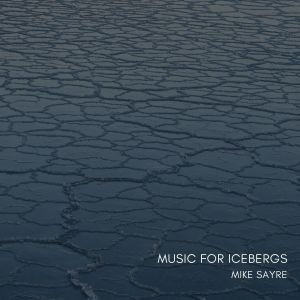Mike Sayre - Music for Icebergs

It’s strange to think of minimalist ambient electronic music
as being political, but it often is. Phillip Glass, for example, almost always
had a political or cultural message in his compositions that was often left up
to his audiences to interpret with no help from language or even giveaway
titles. New York-based composer Mike Sayre is following in those footsteps
somewhat with his EP, due out June 2, called Music for Icebergs. At least in this case there’s a bit of a hint
in the album’s title.
Mike Sayre, like many experimental electronic artists, is classically trained. His first instrument, surprisingly, is the French horn, and he holds a degree from Rutgers for the instrument as well as another from Ball state in Digital Media. The second degree makes more sense in the context of this album, but there is very little French horn on Music for Icebergs, save for a few supportive swells in the closing track, “Elegy”.
Sayre says the five tracks on Music for Icebergs are inspired by the changing climate and its effect on the world’s ice pack, though nothing in the album or his statements about it comes right out and says it’s about global warming. Of course, the fact that proceeds from the album will be donated to various climate change organizations is, however, a pretty strong giveaway.
Cursory literature, charitable causes and titles notwithstanding, in the case of Music for Icebergs listeners may in fact be able to guess the theme anyway. The album is filled with the sounds of howling wind, cracking ice and other ambient sounds which, if nothing else, would make one think of desolate tundra or an icy landscape.
The album’s first single, “Fimbul” is a quite literal example, as its main “melody”, for lack of a better term, is, in fact, a very cold and desolate sounding wind. Also heavily sampled is an almost terrifying cracking sound which one could interpret as splitting wood, but given the wind it almost certainly will conjure up images of being inside an ice cave and said ice cracking, moving, splitting, or in some sections even caving in. Imagining oneself under the ice floes in a massive glacier doesn’t seem far off.
The quite prominent natural glacial sounds in most of the tracks on Music for Icebergs are driven by some interesting electronic feature such as low, almost Schuman resonance-level vibrations and, somewhat, surprisingly, a full orchestral compliment. After all the wind, creaking and cracking of “Fimbul”, the track ends with a symphonic composition of both classical instruments and electronic melodies. “Flows/Floes” is perhaps the most melodic track on the EP, because although it also has a full complement of water-driven “glacial” sounds, it also has a quite beautiful sustained melody throughout.
By the time the closing track, “Elegy” comes around, a pattern can be seen in the way this EP is arranged. It’s definitely a commentary on climate change with a focus on the glaciers and icebergs, as Sayre takes the listener from “Genesis”, or the inception of an iceberg, through “Fimbul”, translated loosely from ancient Norse as “hatchet”, possibly representing calving, to the “Anthropocene” (human) age and eventually the “Elegy” of the earth’s ice packs. If audiences are looking for guidance as to the point of this EP, in this case the titles are very helpful and give an extra poignancy to the music. “Elegy” is a heartwrenching period on the end of the iceberg sentence, and it’s made all the more evocative by the fact that it’s reflecting reality.
If nothing else, Mike Sayre’s Music for Icebergs shows the passion and drama that can be captured in the most unlikely places, like under the ice. The music he composes compliments and underlines this point, and he makes the icebergs part of their own opera of sorts, a performance so visceral that listeners will find themselves feeling the cold and watching their breath as they conjure up images of frozen ice floes, sub-pack caves and icebergs calving in front of their eyes. Music for Icebergs is a wonderful study in the music of nature as well as the plight of the planet right now. It represents the best that experimental ambient music can bring to audiences.
May 31 2017
Mike Sayre, like many experimental electronic artists, is classically trained. His first instrument, surprisingly, is the French horn, and he holds a degree from Rutgers for the instrument as well as another from Ball state in Digital Media. The second degree makes more sense in the context of this album, but there is very little French horn on Music for Icebergs, save for a few supportive swells in the closing track, “Elegy”.
Sayre says the five tracks on Music for Icebergs are inspired by the changing climate and its effect on the world’s ice pack, though nothing in the album or his statements about it comes right out and says it’s about global warming. Of course, the fact that proceeds from the album will be donated to various climate change organizations is, however, a pretty strong giveaway.
Cursory literature, charitable causes and titles notwithstanding, in the case of Music for Icebergs listeners may in fact be able to guess the theme anyway. The album is filled with the sounds of howling wind, cracking ice and other ambient sounds which, if nothing else, would make one think of desolate tundra or an icy landscape.
The album’s first single, “Fimbul” is a quite literal example, as its main “melody”, for lack of a better term, is, in fact, a very cold and desolate sounding wind. Also heavily sampled is an almost terrifying cracking sound which one could interpret as splitting wood, but given the wind it almost certainly will conjure up images of being inside an ice cave and said ice cracking, moving, splitting, or in some sections even caving in. Imagining oneself under the ice floes in a massive glacier doesn’t seem far off.
The quite prominent natural glacial sounds in most of the tracks on Music for Icebergs are driven by some interesting electronic feature such as low, almost Schuman resonance-level vibrations and, somewhat, surprisingly, a full orchestral compliment. After all the wind, creaking and cracking of “Fimbul”, the track ends with a symphonic composition of both classical instruments and electronic melodies. “Flows/Floes” is perhaps the most melodic track on the EP, because although it also has a full complement of water-driven “glacial” sounds, it also has a quite beautiful sustained melody throughout.
By the time the closing track, “Elegy” comes around, a pattern can be seen in the way this EP is arranged. It’s definitely a commentary on climate change with a focus on the glaciers and icebergs, as Sayre takes the listener from “Genesis”, or the inception of an iceberg, through “Fimbul”, translated loosely from ancient Norse as “hatchet”, possibly representing calving, to the “Anthropocene” (human) age and eventually the “Elegy” of the earth’s ice packs. If audiences are looking for guidance as to the point of this EP, in this case the titles are very helpful and give an extra poignancy to the music. “Elegy” is a heartwrenching period on the end of the iceberg sentence, and it’s made all the more evocative by the fact that it’s reflecting reality.
If nothing else, Mike Sayre’s Music for Icebergs shows the passion and drama that can be captured in the most unlikely places, like under the ice. The music he composes compliments and underlines this point, and he makes the icebergs part of their own opera of sorts, a performance so visceral that listeners will find themselves feeling the cold and watching their breath as they conjure up images of frozen ice floes, sub-pack caves and icebergs calving in front of their eyes. Music for Icebergs is a wonderful study in the music of nature as well as the plight of the planet right now. It represents the best that experimental ambient music can bring to audiences.
May 31 2017
Share this review
Facebook
Twitter
Google+
Shares
Buy this release
Teknofonic Recordings
Diskonnekted - Neon Night is available at POPONAUT from 12,95€
Related articles
Out Out - 'Swan/Dive?'
Review, Dec 15 2016
Various Artists - 'AM 10th Anniversary'
Review, Nov 29 2021
Krystal System - 'Rage'
Review, Apr 26 2013
Waves Under Water - 'Red Star'
Review, May 14 2010
Meltdown - 'White'
Review, Jan 01 2005



